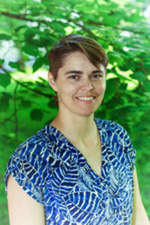Regional varieties in Estonia
Lectures by Triin Todesk (University of Tartu)
at the Institute of Finno-Ugric Studies, LMU
22–26 April 2024
Dr. Triin Todesk is a research fellow of South Estonian varieties at the University of Tartu. She is a member of the work group compiling the Mulgi South Estonian dictionary, and she has several ongoing projects on Seto South Estonian, the corpus of which she has been working on for the past years.
Programme:
Monday, 22 April
12:15–13:45 Talk in the course on dialects in Estonia (Ludwigstraße 31, room 327)
The current research on South Estonian
We will discuss the situation of South Estonian and of its dialects Mulgi, Võro, Seto, Tartu. I will introduce the recent fieldwork in the Seto and Mulgi areas, the corpus of (modern spoken) Seto (and the Corpus of Estonian Dialects). We will discuss the number of speakers of South Estonian based on the previous two censuses (2011, 2021) and the general sociolinguistic situation of South Estonian speakers. I will give an overview of the current research topics of South Estonian (incl. the new Grammar of Võro (to appear 2024/25), the compilation of the Mulgi and Seto dictionaries, case studies of negation (Seto), inflectional morphology (Mulgi), discourse particles (Seto), etc.), other online resources, etc.
Monday, 22 April
14:15–15:45 Talk in the research colloquium of the institute (Ludwigstraße 31, room 327)
The language shift of South Estonian speakers during the Soviet period
This will be the introduction of a case study, an article to appear in 2024 based on an online survey about the language shift of Võro and Seto speakers and their attitudes towards Võro/Seto. In our survey, we concentrated on the mechanisms of intergenerational language transmission, i.e., whom have the different generations acquired their Võro/Seto proficiency from and how many have passed the language on to their children; how much has the language use of parents affected whether and how much a person speaks Võro/Seto with their children, etc. The results of the survey reveal that a steady language shift from Võro/Seto to Estonian has been in progress since the 1960ies. Võro and Seto were moved to the background as granny-languages that had no consistent use, resulting in the language being acquired only partially and not sufficiently to be later transmitted to the speaker’s own children.
Tuesday, 23 April
10:15–11:45 Talk in the course on indigenous languages (Geschwister-Scholl-Platz 1, M 109)
The future of “regional varieties” in Estonia
I will talk a bit about the situation of different “regional varieties” in Estonia (in addition to South Estonian, some North Estonian dialects are also still spoken, e.g., Kodavere in East Estonia, Hiiu-Saare-Kihnu on the islands, etc.). I will also introduce parts of the study we made about the language shift of South Estonian speakers. Aside from that, there are some instances of language revitalisation/conservation/awareness raising going on in Estonia on local levels. Võro and Seto are waiting for the Estonian Language Council to decide about whether they will receive some formal status in Estonia; both Võro people and Setos have declared themselves indigenous peoples in Estonia but their languages have no official status other than being considered “regional varieties”.
Thursday, 25 April
14:15–15:45 Talk in the course on Estonian history (Ludwigstraße 31, room 327)
Language shift of speakers of South Estonian and dialects of North Estonian in the 20th century
This talk will introduce the findings of an online survey about the language shift of South Estonian speakers during the Soviet era. I will address the situation in other dialect areas as well. I will talk about language planning and the creation of Standard Estonian, and the role of dialects in the process. Although this may be suggested in general, it is not only the Soviet government that is responsible for the nivelation of dialect traits – the language planning of the Estonian Republic of the 1920ies began with the idealisation of the “cultured language” while deeming dialects as “low” or “uncultured”. This attitude has more or less survived until modern times and is currently raising a lively debate in the media about language planning and the supposed necessity of strongly keeping to the normed language and rejecting other registers.
Friday, 26 April
18:00–19:30 Talk in Estonian (Ludwigstraße 31, room 327)
Lõunaeesti keelest ja (põhja)eesti keele murretest
Juttu tuleb eesti murrete ja lõunaeesti keele olukorrast, nende keelekujude säilitamisest ja taaselustamisest, aga ka teaduslikust uurimisest ja olulisusest kirjakeele elujõulisuse seisukohalt. Räägin välitöödest lõunaeesti keelealal võru, seto ja mulgi keele piirkondades, seto keele ja eesti murrete korpuse koostamisest, võru keele grammatikast, ja üldisemalt lõunaeesti keele uurimisest. Vaatame Põhja-Eesti aladel räägitud Kodavere, rannakeele, saare, hiiu, kihnu, ja muhu keele kõnelejate püüdlusi oma piirkonnas kõneldud keelt taaselustada ning uuesti kasutusele võtta. Kõige selle kõrvale räägime kindlasti ka eesti kirjakeelest ja selle suhetest nö mittenormeeritud keelega.
For further information and requests concerning ECTS points, please contact Tiia Palosaar tiia.palosaar@lmu.de. Welcome to the lectures!
Downloads
- Triin Todesk LMU (167 KByte)


